Time Series Analysis to Estimate the Volume of Drinking Water Consumption in the City of Meoqui, Chihuahua, Mexico
Abstract
:1. Introduction
2. Materials and Methods
2.1. Research Site
2.2. Junta Municipal de Aguas y Saneamiento (JMAS) of Meoqui, Chihuahua
2.3. Data Collection
- Domestic: residential dwellings.
- Commercial: comprises businesses engaged in the sale and purchase of goods and services.
- Public: focus is on governmental institutions.
- Education: encompasses schools.
- Industrial: comprises companies engaged in productive business activities, with the exception of those involved in the brewing industry.
- Raw water: companies engaged in the brewing industry.
2.4. Data Analyses
2.5. ARIMA Model Forecast
2.6. Sen’s Slope Estimator
2.7. Mann-Kendall Trend Test
3. Results
3.1. Descriptive Analysis Approach
Total Consumption
3.2. Time Series Analysis
3.2.1. Total Population
3.2.2. Domestic Sector
3.2.3. Commercial Sector
3.2.4. Public Sector
3.2.5. Education Sector
3.2.6. Industrial Sector
3.2.7. Raw Water Sector
4. Discussion
5. Conclusions
Author Contributions
Funding
Data Availability Statement
Acknowledgments
Conflicts of Interest
References
- Postel, S.L. Water and world population growth. J.-Am. Water Work. Assoc. 2000, 92, 131–138. [Google Scholar] [CrossRef]
- Peydayesh, M.; Mezzenga, R. Protein nanofibrils for next generation sustainable water purification. Nat. Commun. 2021, 12, 3248. [Google Scholar] [CrossRef] [PubMed]
- Buttinelli, R.; Cortignani, R.; Caracciolo, F. Irrigation water economic value and productivity: An econometric estimation for maize grain production in Italy. Agric. Water Manag. 2024, 295, 108757. [Google Scholar] [CrossRef]
- Larraz, B.; García-Rubio, N.; Gámez, M.; Sauvage, S.; Cakir, R.; Raimonet, M.; Pérez, J.M.S. Socio-Economic Indicators for Water Management in the South-West Europe Territory: Sectorial Water Productivity and Intensity in Employment. Water 2024, 16, 959. [Google Scholar] [CrossRef]
- MacAllister, D.J. Groundwater Decline Is Global but not Universal; Nature Publishing Group UK London: London, UK, 2024. [Google Scholar]
- Henao, C.; Lis-Gutiérrez, J.P.; Lis-Gutiérrez, M.; Ariza-Salazar, J. Determinants of efficient water use and conservation in the Colombian manufacturing industry using machine learning. Humanit. Soc. Sci. Commun. 2024, 11, 1–11. [Google Scholar] [CrossRef]
- Environment Institute, S. 6 Clean Water and Sanitation. The Government of Sweden; 2024. Available online: https://www.government.se/government-policy/the-global-goals-and-the-2030-Agenda-for-sustainable-development/goal-6-clean-water-and-sanitation/ (accessed on 15 August 2024).
- El Garouani, M.; Radoine, H.; Lahrach, A.; Jarar Oulidi, H. Spatiotemporal Analysis of Groundwater Resources in the Saïss Aquifer, Morocco. Water 2022, 15, 105. [Google Scholar] [CrossRef]
- Roy, S.; Taloor, A.K.; Bhattacharya, P. A geospatial approach for understanding the spatio-temporal variability and projection of future trend in groundwater availability in the Tawi basin, Jammu, India. Groundw. Sustain. Dev. 2023, 21, 100912. [Google Scholar] [CrossRef]
- Montgomery, M.A.; Elimelech, M. Water and sanitation in developing countries: Including health in the equation. Environ. Sci. Technol. 2007, 41, 17–24. [Google Scholar] [CrossRef] [PubMed]
- Ochoa, C.G.; Villarreal-Guerrero, F.; Prieto-Amparán, J.A.; Garduño, H.R.; Huang, F.; Ortega-Ochoa, C. Precipitation, Vegetation, and Groundwater Relationships in a Rangeland Ecosystem in the Chihuahuan Desert, Northern Mexico. Hydrology 2023, 10, 41. [Google Scholar] [CrossRef]
- R Core Team. R: A Language and Environment for Statistical Computing; R Foundation for Statistical Computing: Vienna, Austria, 2024. [Google Scholar]
- Robinson, D.; Hayes, A.; Couch, S. Broom: Convert Statistical Objects into Tidy Tibbles. 2024. Available online: https://CRAN.R-project.org/package=broom (accessed on 15 September 2024).
- Kuhn, M.; Frick, H. Dials: Tools for Creating Tuning Parameter Values. 2024. Available online: https://CRAN.R-project.org/package=dials (accessed on 15 September 2024).
- Wickham, H.; François, R.; Henry, L.; Müller, K.; Vaughan, D. Dplyr: A Grammar of Data Manipulation. 2023. Available online: https://CRAN.R-project.org/package=dplyr (accessed on 15 September 2024).
- Wickham, H. forcats: Tools for Working with Categorical Variables (Factors). 2023. Available online: https://CRAN.R-project.org/package=forcats (accessed on 15 September 2024).
- Wickham, H. Ggplot2: Elegant Graphics for Data Analysis; Springer: New York, NY, USA, 2016; Available online: https://ggplot2.tidyverse.org (accessed on 15 September 2024).
- Couch, S.P.; Bray, A.P.; Ismay, C.; Chasnovski, E.; Baumer, B.S.; Çetinkaya-Rundel, M. infer: An R package for tidyverse-friendly statistical inference. J. Open Source Softw. 2021, 6, 3661. [Google Scholar] [CrossRef]
- Grolemund, G.; Wickham, H. Dates and Times Made Easy with lubridate. J. Stat. Softw. 2011, 40, 1–25. [Google Scholar] [CrossRef]
- Kuhn, M. modeldata: Data Sets Useful for Modeling Examples. 2024. Available online: https://CRAN.R-project.org/package=modeldata (accessed on 15 September 2024).
- Dancho, M. Modeltime: The Tidymodels Extension for Time Series Modeling. 2024. Available online: https://CRAN.R-project.org/package=modeltime (accessed on 15 September 2024).
- Aust, F.; Barth, M. Papaja: Prepare Reproducible APA Journal Articles with R Markdown. 2023. Available online: https://github.com/crsh/papaja (accessed on 15 September 2024).
- Kuhn, M.; Vaughan, D. Parsnip: A Common API to Modeling and Analysis Functions. 2024. Available online: https://CRAN.R-project.org/package=parsnip (accessed on 15 September 2024).
- Wickham, H.; Henry, L. Purrr: Functional Programming Tools. 2023. Available online: https://CRAN.R-project.org/package=purrr (accessed on 15 September 2024).
- Wickham, H.; Hester, J.; Bryan, J. Readr: Read Rectangular Text Data. 2024. Available online: https://CRAN.R-project.org/package=readr (accessed on 15 September 2024).
- Kuhn, M.; Wickham, H.; Hvitfeldt, E. Recipes: Preprocessing and Feature Engineering Steps for Modeling. 2024. Available online: https://CRAN.R-project.org/package=recipes (accessed on 15 September 2024).
- Wickham, H. Reshaping Data with the reshape Package. J. Stat. Softw. 2007, 21, 1–20. [Google Scholar] [CrossRef]
- Frick, H.; Chow, F.; Kuhn, M.; Mahoney, M.; Silge, J.; Wickham, H. rsample: General Resampling Infrastructure. 2024. Available online: https://CRAN.R-project.org/package=rsample (accessed on 15 September 2024).
- Wickham, H.; Pedersen, T.L.; Seidel, D. Scales: Scale Functions for Visualization. 2023. Available online: https://CRAN.R-project.org/package=scales (accessed on 15 September 2024).
- Wickham, H. Stringr: Simple, Consistent Wrappers for Common String Operations. 2023. Available online: https://CRAN.R-project.org/package=stringr (accessed on 15 September 2024).
- Müller, K.; Wickham, H. Tibble: Simple Data Frames. 2023. Available online: https://CRAN.R-project.org/package=tibble (accessed on 15 September 2024).
- Kuhn, M.; Wickham, H. Tidymodels: A Collection of Packages for Modeling and Machine Learning Using Tidyverse Principles. 2020. Available online: https://www.tidymodels.org (accessed on 15 September 2024).
- Wickham, H.; Vaughan, D.; Girlich, M. Tidyr: Tidy Messy Data. 2024. Available online: https://CRAN.R-project.org/package=tidyr (accessed on 15 September 2024).
- Dancho, M.; Vaughan, D. Timetk: A Tool Kit for Working with Time Series. 2023. Available online: https://CRAN.R-project.org/package=timetk (accessed on 15 September 2024).
- Barth, M. Tinylabels: Lightweight Variable Labels. 2023. Available online: https://cran.r-project.org/package=tinylabels (accessed on 15 September 2024).
- Pohlert, T. Trend: Non-Parametric Trend Tests and Change-Point Detection. 2023. Available online: https://CRAN.R-project.org/package=trend (accessed on 15 September 2024).
- Kuhn, M. Tune: Tidy Tuning Tools. 2024. Available online: https://CRAN.R-project.org/package=tune (accessed on 15 September 2024).
- Vaughan, D.; Couch, S. Workflows: Modeling Workflows. 2024. Available online: https://CRAN.R-project.org/package=workflows (accessed on 15 September 2024).
- Kuhn, M.; Couch, S. Workflowsets: Create a Collection of “Tidymodels” Workflows. 2024. Available online: https://CRAN.R-project.org/package=workflowsets (accessed on 15 September 2024).
- Kuhn, M.; Vaughan, D.; Hvitfeldt, E. Yardstick: Tidy Characterizations of Model Performance. 2024. Available online: https://CRAN.R-project.org/package=yardstick (accessed on 15 September 2024).
- Box, G.E.P.; Jenkins, G.M.; Reinsel, G.C.; Ljung, G.M. Time Series Analysis. Forecasting and Control, 5th ed.; John Wiley & Sons, Inc.: Hoboken, NJ, USA, 2016. [Google Scholar]
- Hyndman, R.J.; Athanasopoulos, G. Forecasting: Principles and Practice, 3rd ed.; OTexts: Melbourne, Australia, 2021; Available online: https://otexts.com/fpp3/ (accessed on 15 September 2024).
- Patle, G.T.; Singh, D.K.; Sarangi, A.; Rai, A.; Khanna, M.; Sahoo, R.N. Time series analysis of groundwater levels and projection of future trend. J. Geol. Soc. India 2015, 85, 232–242. [Google Scholar] [CrossRef]
- Sen, P.K. Estimates of the Regression Coefficient Based on Kendall’s Tau. J. Am. Stat. Assoc. 1968, 63, 1379–1389. [Google Scholar] [CrossRef]
- Kendall, M.G. Rank Correlation Methods; Charles Griffin: London, UK, 1970. [Google Scholar]
- Krishnakumar, P.; Lakshumanan, C.; Kishore, V.P.; Sundararajan, M.; Santhiya, G.; Chidambaram, S. Assessment of groundwater quality in and around Vedaraniyam, South India. Env. Earth Sci. 2014, 71, 2211–2225. [Google Scholar] [CrossRef]
- United Nations WWD. Valuing Water for the Economy. 2021–2023 [Internet]. 2023. Available online: https://www.unesco.org/reports/wwdr/2021/en/valuing-water-economy (accessed on 12 August 2024).
- Neme Castillo, O.; Valderrama Santibañez, A.L.; Chiatchoua, C. Determinants of productive water consumption and effects on economic activity in Mexico. Econ. Soc. Territ. 2021, 21, 505–537. [Google Scholar]
- Rahim, M.S.; Nguyen, K.A.; Stewart, R.A.; Giurco, D.; Blumenstein, M. Machine learning and data analytic techniques in digital water metering: A review. Water 2020, 12, 294. [Google Scholar] [CrossRef]
- Markanicz, J.; MMikołajczak, M. Czy świadomość na temat fast fashion ma wpływ na decyzje zakupowe konsumentów? Teor. I Prakt. Dydakt. Akademickiej. 2024, 1. Available online: https://czasopisma.bg.ug.edu.pl/index.php/TiPDA/article/view/10650 (accessed on 19 August 2024).
- André, F.J.; Buendía, A.; Santos-Arteaga, F.J. Efficient water use and reusing processes across Spanish regions: A circular data envelopment analysis with undesirable inputs. J. Clean. Prod. 2024, 434, 139929. [Google Scholar] [CrossRef]
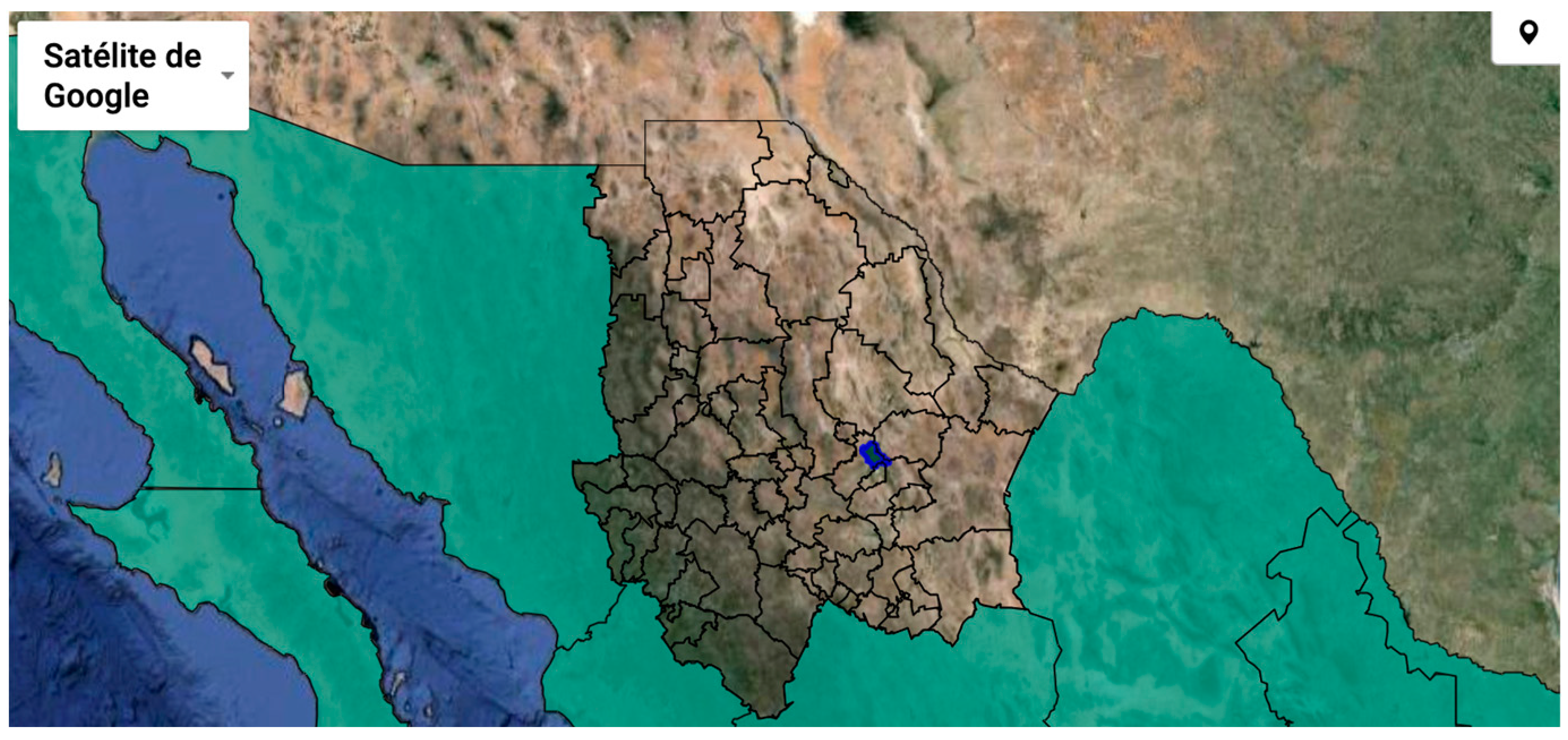
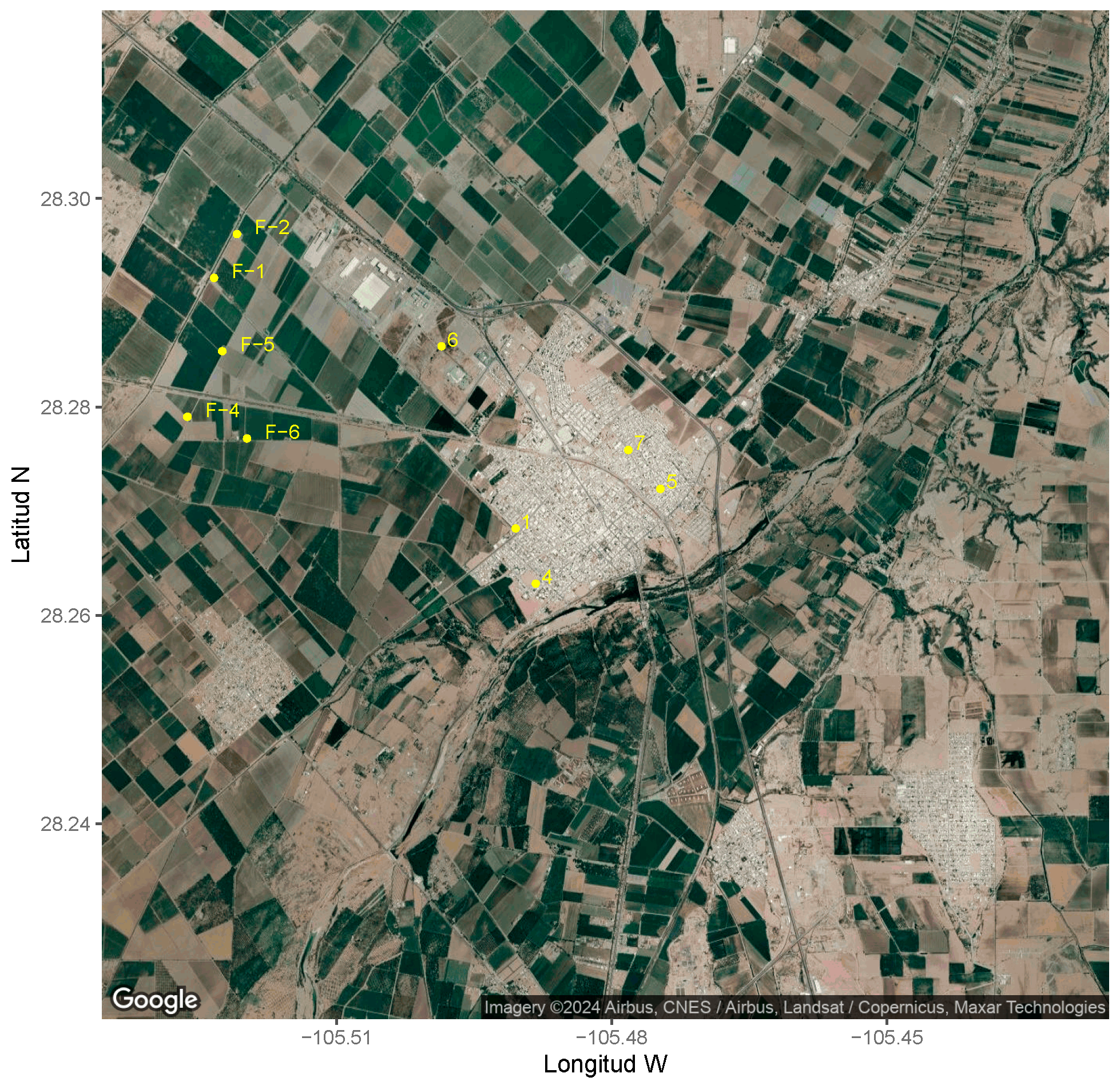
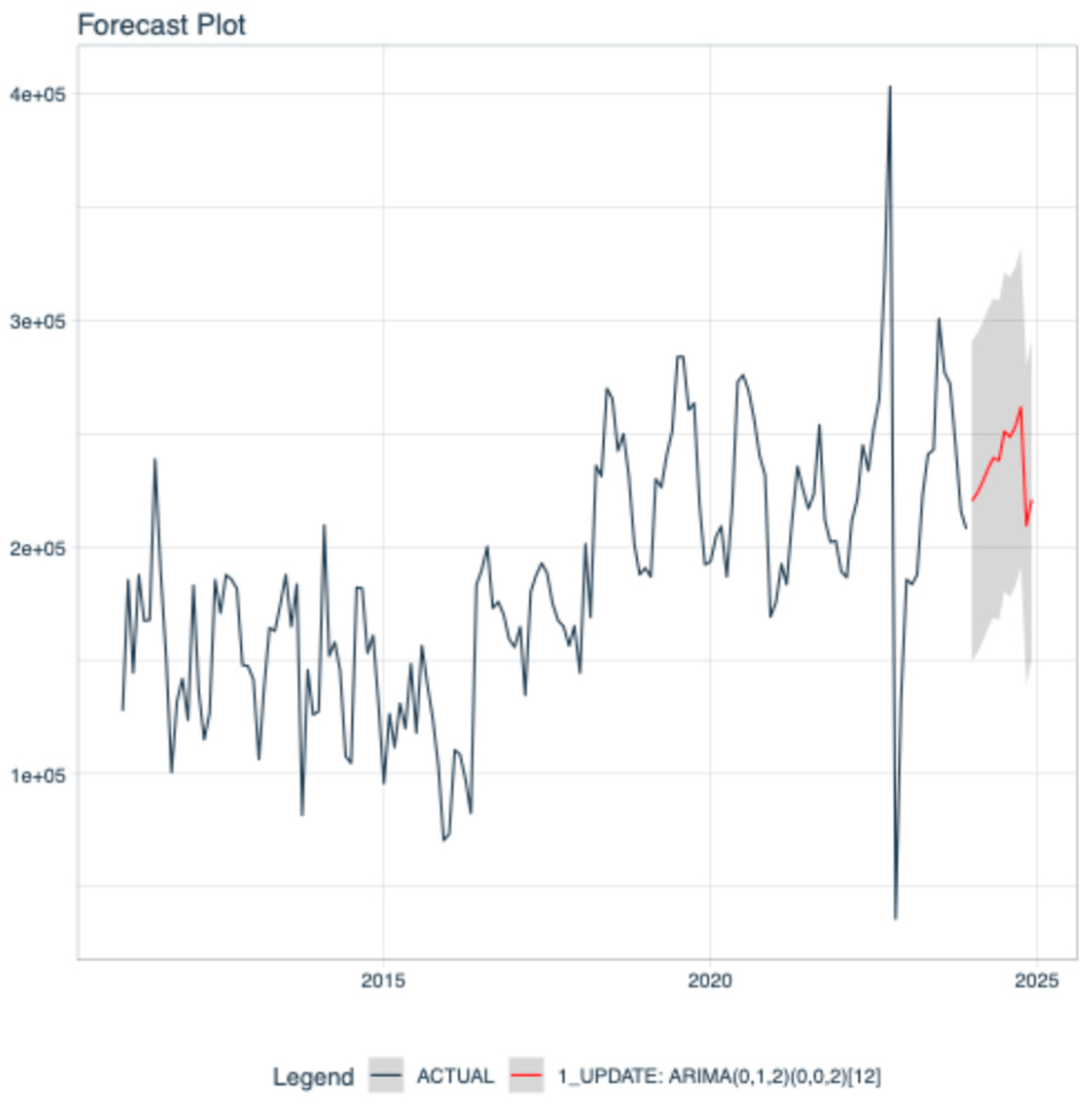



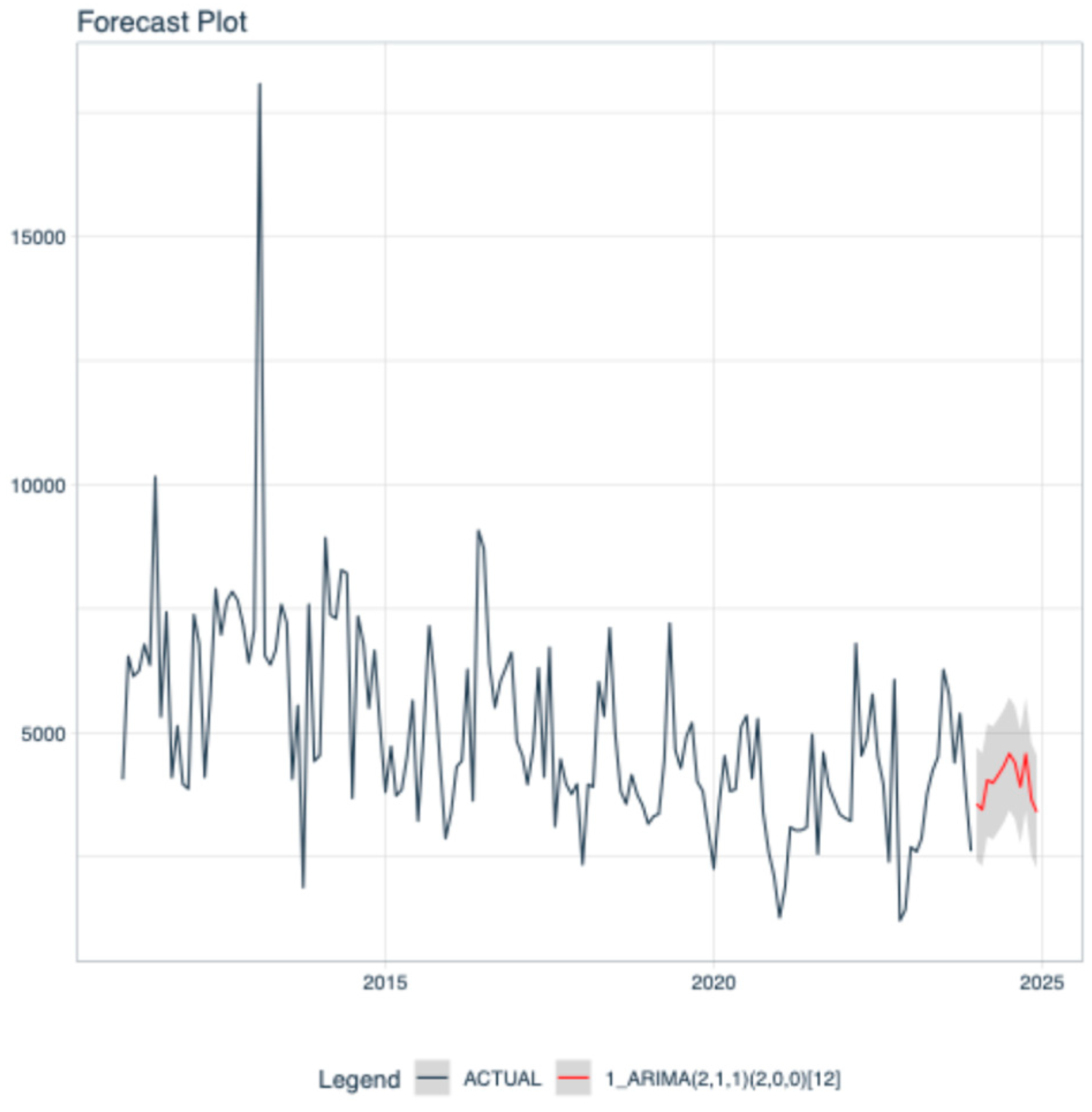
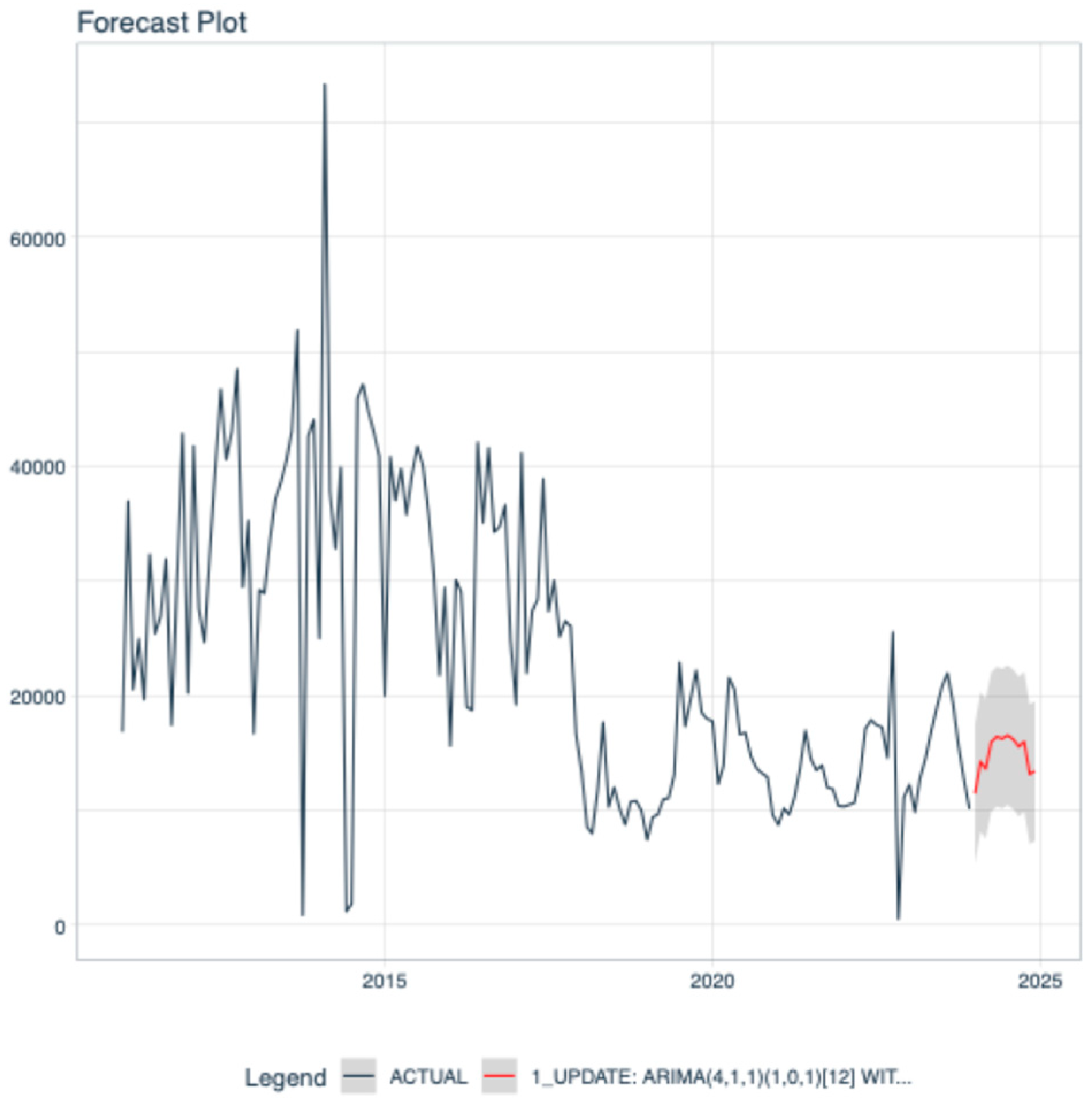

| Mean | Sd | Sum | |
|---|---|---|---|
| Domestic | 13 | 93 | 17,169,009 |
| Commercial | 16 | 126 | 1,460,194 |
| Public | 38 | 108 | 585,201 |
| Education | 95 | 237 | 780,562 |
| Industrial | 1536 | 5945 | 3,695,017 |
| Raw water | 30,146 | 35,841 | 5,124,795 |
Disclaimer/Publisher’s Note: The statements, opinions and data contained in all publications are solely those of the individual author(s) and contributor(s) and not of MDPI and/or the editor(s). MDPI and/or the editor(s) disclaim responsibility for any injury to people or property resulting from any ideas, methods, instructions or products referred to in the content. |
© 2024 by the authors. Licensee MDPI, Basel, Switzerland. This article is an open access article distributed under the terms and conditions of the Creative Commons Attribution (CC BY) license (https://creativecommons.org/licenses/by/4.0/).
Share and Cite
Legarreta-González, M.A.; Meza-Herrera, C.A.; Rodríguez-Martínez, R.; Chávez-Tiznado, C.S.; Véliz-Deras, F.G. Time Series Analysis to Estimate the Volume of Drinking Water Consumption in the City of Meoqui, Chihuahua, Mexico. Water 2024, 16, 2634. https://doi.org/10.3390/w16182634
Legarreta-González MA, Meza-Herrera CA, Rodríguez-Martínez R, Chávez-Tiznado CS, Véliz-Deras FG. Time Series Analysis to Estimate the Volume of Drinking Water Consumption in the City of Meoqui, Chihuahua, Mexico. Water. 2024; 16(18):2634. https://doi.org/10.3390/w16182634
Chicago/Turabian StyleLegarreta-González, Martín Alfredo, César A. Meza-Herrera, Rafael Rodríguez-Martínez, Carlos Servando Chávez-Tiznado, and Francisco Gerardo Véliz-Deras. 2024. "Time Series Analysis to Estimate the Volume of Drinking Water Consumption in the City of Meoqui, Chihuahua, Mexico" Water 16, no. 18: 2634. https://doi.org/10.3390/w16182634









